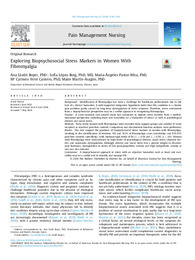Por favor, use este identificador para citar o enlazar este ítem:
https://hdl.handle.net/11000/33583
Exploring Biopsychosocial Stress Markers in Women With
Fibromyalgia
Título :
Exploring Biopsychosocial Stress Markers in Women With
Fibromyalgia |
Autor :
Lledó, Ana 
López Roig, Sofía 
Pastor-Mira, María Ángeles 
Terol Cantero, M Carmen 
MARTÍN-ARAGÓN, MAITE  |
Editor :
Elsevier |
Departamento:
Departamentos de la UMH::Ciencias del Comportamiento y salud |
Fecha de publicación:
2024 |
URI :
https://hdl.handle.net/11000/33583 |
Resumen :
Background: Identification of fibromyalgia has been a challenge for healthcare professionals due to the lack of a clinical biomarker. A well-supported integrative hypothesis holds that this condition is a chronic pain problem partly caused by long-term dysregulation of stress response. Therefore, stress assessment from a biopsychosocial perspective may be a useful approach to recognizing fibromyalgia. Purpose: A cross-sectional case-control study was conducted to explore stress markers from a multidi- mensional perspective, including heart rate variability (as a biomarker of stress) as well as psychological distress and social stress. Methods: Forty-seven women with fibromyalgia were recruited from support groups and another 47 were recruited as matched pain-free controls. Comparison and discriminant function analyses were performed. Results: The data support the goodness of biopsychosocial stress markers in women with fibromyalgia, resulting in the identification of between 70% and 74.5% of fibromyalgia cases (sensitivity) and 85%-87% pain-free controls (specificity), with medium-high levels of fit ( λ= 0.58 and λ= 0.59; p < .00). Women with fibromyalgia were characterized by high levels of psychological distress, social stress (disorder lev- els), and autonomic dysregulation. Although distress and social stress had a greater weight in discrimi- nant functions, dysregulation in terms of low parasympathetic activity and high sympathetic activity at rest was also relevant. Conclusions: A biopsychosocial approach to stress with an objective biomarker such as heart rate vari- ability may be a useful tool to identify and manage FM.
|
Área de conocimiento :
CDU: Filosofía y psicología: Psicología |
Tipo de documento :
info:eu-repo/semantics/article |
Derechos de acceso:
info:eu-repo/semantics/openAccess |
DOI :
https://doi.org/10.1016/j.pmn.2024.05.008 |
Publicado en:
Pain Management Nursing 25 (2024) |
Aparece en las colecciones:
Artículos Ciencias del Comportamiento y Salud
|
 La licencia se describe como: Atribución-NonComercial-NoDerivada 4.0 Internacional.
La licencia se describe como: Atribución-NonComercial-NoDerivada 4.0 Internacional.
 La licencia se describe como: Atribución-NonComercial-NoDerivada 4.0 Internacional.
La licencia se describe como: Atribución-NonComercial-NoDerivada 4.0 Internacional.
.png)
